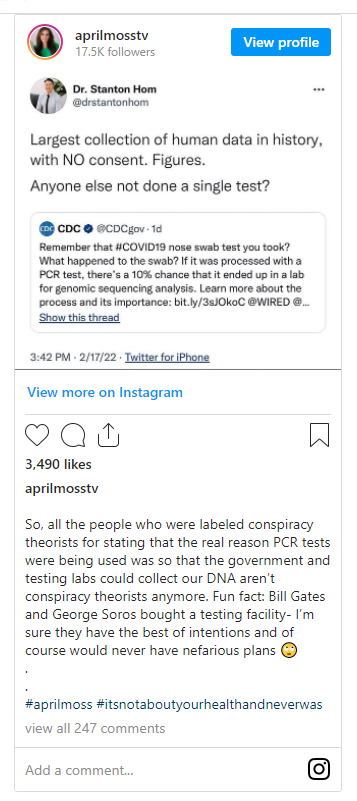
Is the Centers for Disease Control and Prevention collecting DNA through COVID-19 test samples? No, that's not true: The CDC published a tweet on February 16, 2022, that stated that if a person took a COVID nose swab test there was "a 10% chance that it ended up in a lab for genomic sequencing analysis." The following day, February 17, 2022, the CDC clarified that the testing is of the virus and not people's DNA. A misleading social media message was posted after the CDC issued a clarification and did not note the correction.
The claim appeared in an Instagram post on February 18, 2022. It opened:
Largest collection of human data in history, with NO consent. Figures. Anyone else not done a single test?
Users on social media saw this:
(Source: Instagram screenshot taken Tues Feb 22 at 12:40:16 2022 UTC)
The Instagram post is a screenshot of a tweet posted on February 17, 2022, by the account @drstantonhom:
Largest collection of human data in history, with NO consent. Figures.
-- Dr. Stanton Hom (@drstantonhom) February 17, 2022
Anyone else not done a single test? https://t.co/1sRhh3ybJz
The CDC tweet was posted on February 16, 2022:
Remember that #COVID19 nose swab test you took? What happened to the swab? If it was processed with a PCR test, there's a 10% chance that it ended up in a lab for genomic sequencing analysis. Learn more about the process and its importance: https://t.co/XAHSGANLxu @WIRED @CDC_AMD
-- CDC (@CDCgov) February 16, 2022
The CDC posted an updated tweet at 2:52 p.m. on February 17, 2022:
Our @CDC_AMD @WIRED video tweet led to some confusion. To clarify: CDC and our partners conduct genome sequencing analysis of the virus that causes COVID-19. Sequencing of the virus helps identify and monitor the spread and impact of variants. https://t.co/D9iNC7OPFL
-- CDC (@CDCgov) February 17, 2022
Hom posted his tweet at 6:42 p.m. on February 17, 2022, hours after the CDC posted their correction.
CDC spokesperson Jasmine Reed clarified the genomic sequencing tweet to Lead Stories via email on February 22, 2022:
Last week, a CDC tweet regarding genomic sequencing led some people to believe that personal identifying information was included in samples processed in the sequencing program. That is not the case. Laboratories around the country examine viral sequences from positive samples which contain no personal identifying information. CDC analyzes SARS-CoV-2 genetic sequences from these labs to identify and compare variants, monitor their spread and evaluate the potential impact on medical treatments and vaccines.
The email from the CDC shared a link to the website section titled, "CDC's Role in Tracking Variants":
What is CDC doing to track SARS-COV-2 variants?
In the United States, CDC uses genomic surveillance to track emerging SARS-CoV-2 variants that cause COVID-19. CDC established multiple pipelines to connect genomic sequence data from CDC, public health laboratories, and commercial diagnostic laboratories within publicly accessible databases maintained by the National Center for Biotechnology Information (NCBI) and the Global Initiative on Sharing Avian Influenza Data (GISAID).As part of the CDC National SARS-CoV-2 Strain Surveillance (NS3) System, public health laboratories ship deidentified specimens to CDC to provide a representative set of viruses for sequencing. There are four main stages in the process of generating SARS-CoV-2 genetic sequence data from these specimens and making it available in public repositories.

















